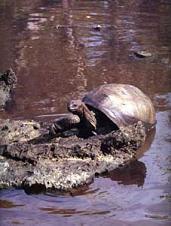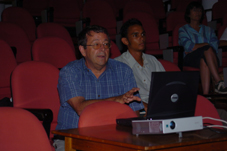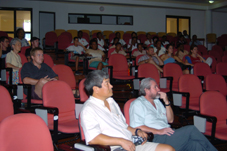Research indicates tortoise population on Aldabra in good shape |19 July 2004

Dr Jason Bourn of Environmental Research Group Oxford (ERGO) said on Thursday July 15 that it appears tortoise populations on the remote atoll might be levelling off after a period of rapid growth that began during the early 1900s.
The British researcher was speaking during a presentation at the National Institute of Education Thursday afternoon hosted by the Seychelles Islands Foundation (SIF), the managing body of Aldabra.

Dr Bourn’s research indicates that the current tortoise population is estimated at about 100,000 individuals, which entrenches Aldabra as having the largest land tortoise population in the world.
Similar research conducted by Dr Bourn between 1973-74, who was with the Royal Society at the time, estimated the population then to be between 130,000-150,000. Dr Bourn however, attributes the 23 percent decline to Aldabra overextending its carrying capacity for the turtles, which resulted in a natural population fall.
During his presentation Dr Bourn outlined the estimated population levels of Aldabra since modern exploration began to take note of the slow-moving creatures.
In the early 1800s, Aldabra was described as being “abound with tortoises,” but with the start of commercial whaling around 1825, the population was decimated by heavy exploitation, and in 1910 was deemed “very scarce.”
Soon after, the realisation of the need to conserve the tortoises became evident, and by 1929 the population had begun to flourish again, leading up to Dr Bourn’s 1974 maximum estimate of nearly 150,000.
Most earlier estimates, however, which ranged from “no less than 1,000” at one point to 80,000 in another, were subjective and not systematic, Dr Bourn said. Thorough work in determining the population was difficult to perform on Aldabra, which consists of 138 square km of difficult terrain and dense vegetation.
But beginning with one study in 1967, followed up by the Royal Society in the early ‘70s, researchers began employing more scientific methods to get estimates.
The research methods employed by Dr Bourn then – and in similar but modified follow-up studies since – involve categorising the different types of terrain across the different islands of the atoll, then sampling population densities in such areas to get an overall estimate.
Dr Bourn added that the tortoise population did take a dip starting after 1997, but a drought in the mid ‘90s is largely believed to be the cause of the crash, and populations have since recovered back to around 100,000, according to the estimates.
“They’re incredibly resilient animals,” he said.
Dr Bourn said that UNESCO, which features Aldabra as a world heritage site, has provided funding for research software and a user-friendly database that can be constantly updated as more information is supplied from SIF field personnel on Aldabra. The database, which can take existing information and calculate estimates in seconds, would greatly help as a tool for the atoll’s management, he said.





